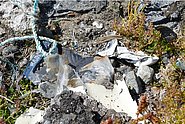The glacier microbiome
2023 - 2026
FinancingGlacier ice is an important reservoir for bacteria and viruses. Some of these microorganisms were trapped in the ice for hundreds or thousands of years and are now being released into the environment as a result of ongoing climate change. The microbial diversity of Swiss glaciers, as well as their activity and infectivity, is still largely unexplored. Using state-of-the-art DNA sequencing methods, new insights can now be gained into the future development of the microbial diversity in the Alpine region.
In order to better understand the microbial diversity of Swiss glaciers, glaciers are sampled along an east-west transect. Both meltwater and ice samples are analysed in the laboratory to obtain an overview of bacteria and viruses.
Glacier ice also provides a unique opportunity to observe the evolution of bacteriophages (viruses that infect bacteria). Ice samples of different ages from a glacier provide an insight into the history of bacteriophages over centuries to millennia. This allows us to analyse the interplay between bacteria and viruses and to draw conclusions about the future impact of glacier melting on microbial diversity in the Swiss Alps.
The majority of viruses in the environment use bacteria as host cells (bacteriophages). Phages are significant regulators of bacterial populations in the glacier ice and play an important role in the biogeochemical cycles of glaciers. Due to years of adaptation to 'life' in the ice, it is unclear whether these phages remain infectious even after the ice melts. To test this, phages from glacier samples can be enriched and their infectivity can be tested under laboratory conditions.
Frequently asked questions ¶
- Is there a risk from potential pathogens released from melting ice?
Although it is possible that pathogenic microorganisms survive in glaciers and permafrost, we estimate the risk of a potential release of a pathogen from the melting ice and thawing permafrost to be very low. These organisms have adapted in the cold for centuries to millennia. We think that they can hardly survive in a warming environment - firstly because of the temperatures and secondly because, in the case of viruses, they must find and infect new bacterial or eukaryotic hosts, i.e. animal, human or plant cells. So far, no infectious pathogens from permafrost or melting glaciers have been discovered in the Swiss Alps.
Projects ¶
Publications ¶
Feng M., Robinson S., Qi W., Edwards A., Stierli B., van der Heijden M., … Varliero G. (2024) Microbial genetic potential differs among cryospheric habitats of the Damma glacier. Microb. Genom. 10(10), 001301 (17 pp.). https://doi.org/10.1099/mgen.0.001301Institutional Repository DORA
Varliero G., Lebre P.H., Frey B., Fountain A.G., Anesio A.M., Cowan D.A. (2023) Glacial water: a dynamic microbial medium. Microorganisms. 11(5), 1153 (24 pp.). https://doi.org/10.3390/microorganisms11051153Institutional Repository DORA
Donhauser J., Niklaus P.A., Rousk J., Larose C., Frey B. (2020) Temperatures beyond the community optimum promote the dominance of heat-adapted, fast growing and stress resistant bacteria in alpine soils. Soil Biol. Biochem. 148, 107873 (16 pp.). https://doi.org/10.1016/j.soilbio.2020.107873Institutional Repository DORA
Donhauser J., Frey B. (2018) Alpine soil microbial ecology in a changing world. FEMS Microbiol. Ecol. 94(9), 099 (34 pp.). https://doi.org/10.1093/femsec/fiy099Institutional Repository DORA
Rime T., Hartmann M., Frey B. (2016) Potential sources of microbial colonizers in an initial soil ecosystem after retreat of an alpine glacier. ISME J. 10(7), 1625-1641. https://doi.org/10.1038/ismej.2015.238 Institutional Repository DORA
Rime T., Hartmann M., Brunner I., Widmer F., Zeyer J., Frey B. (2015) Vertical distribution of the soil microbiota along a successional gradient in a glacier forefield. Mol. Ecol. 24(5), 1091-1108. https://doi.org/10.1111/mec.13051 Institutional Repository DORA
Zumsteg A., Luster J., Göransson H., Smittenberg R.H., Brunner I., Bernasconi S.M., … Frey B. (2012) Bacterial, archaeal and fungal succession in the forefield of a receding glacier. Microb. Ecol. 63(3), 552-564. https://doi.org/10.1007/s00248-011-9991-8 Institutional Repository DORA
Links ¶
-
SWI swissinfo.ch, 05.01.2025: Secrets revealed by melting Swiss glaciers could eat plastic and cure disease
-
Podcast of SWI swissinfo.ch, 10.12.2024: Unveiling Ancient Life: Microorganisms in Melting Glaciers in Swiss Alps








